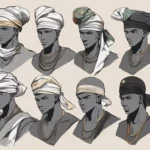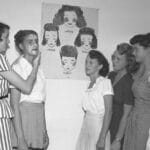Unpacking the Real Woman Behind the Icon
We’ve all seen her: biceps flexed, a determined look on her face, a red bandana holding back her work-ready hair. Rosie the Riveter. She’s more than just a cool picture – she’s a symbol, a feeling, a reminder of how powerful women can be. But there’s a lot more to her story than meets the eye.
Behind the Poster: The Real Rosies
We tend to imagine Rosie as this one woman, always white and always rocking that bandana. But the truth is, “Rosie” wasn’t just one person. She represented thousands of women from all walks of life – different races, different backgrounds – who stepped up during World War II. There were “Black Rosies” facing segregation in the factories, Latina, Asian American, and Native American women all playing their part.
These women were the unsung heroes on the home front. To learn more about the pivotal events and hardships that shaped the lives of women during this era, explore the in-depth Frederick Douglass timeline.
More Than Morale: From Factory Floors to Feminist Icon
Think about that “We Can Do It!” poster. It was meant to keep workers’ spirits up, sure, but it became something much bigger. That image, along with Norman Rockwell’s famous Saturday Evening Post cover, turned Rosie into a symbol of female strength and independence. She showed the world that women were capable, strong, and ready to roll up their sleeves when needed.
A Legacy of Empowerment: Rosie’s Influence Today
Rosie’s influence didn’t fade after the war. She became a powerful symbol for feminist movements and a reminder that women deserved equal rights and opportunities. Even today, you see her image everywhere – in protests, in ads, in movies – a timeless reminder of women’s contributions and potential.
If you’re curious about the circumstances that led to the disbandment of social structures that limited women’s roles after the war, delving into the article on when did the Revolution disband will provide insightful answers.
Reimagining Rosie: Modern Takes on a Classic
Artists and activists continue to be inspired by Rosie. They’re creating modern versions of her, reflecting the diversity of women and the ongoing fight for equality. These new images show that Rosie’s message is still relevant; it’s about breaking barriers, challenging stereotypes, and celebrating the power of women from all backgrounds.
A Picture’s Worth a Thousand Words: The Power of Rosie
The story of Rosie the Riveter proves just how powerful a single image can be. She embodies resilience, strength, and the power of collective action. She reminds us that women have always been a force to be reckoned with, and their contributions deserve to be celebrated.
Intrigued by the lives of the spirited and adventurous women who came after Rosie? Discover their captivating stories in the informative piece on Ingals Wilder daughters.
Who Was the Real-Life Rosie the Riveter?
So, we’ve talked about this iconic image, this powerful symbol of Rosie the Riveter. But who was she really? Was there actually a single “Rosie” flexing her muscles on posters and inspiring a nation?
Well, the “We Can Do It!” poster, the one everyone knows, was designed by J. Howard Miller in 1942. Now, while this image screams “Rosie” to us now, back then it was more of an internal motivational thing for factory workers.
It was actually Norman Rockwell, the famous painter, who really put Rosie on the map. His 1943 Saturday Evening Post cover, featuring a strong woman taking her lunch break, toolbox at her feet, became a sensation. He called her “Rosie,” and the name stuck.
Naturally, people got curious. If there was a Rosie in the picture, who was the woman behind that determined look? Several women have been linked to the image over the years. For a long time, people thought Geraldine Hoff Doyle, a factory worker from Michigan, was the one in the “We Can Do It!” poster. Then there’s Rose Will Monroe, who appeared in wartime films promoting war bonds and was called “Rosie” by many.
In the 2010s, the family of Naomi Parker Fraley stepped forward, claiming she was the real deal behind Miller’s poster. And they had convincing photos to back it up. Since then, even some historians have come around to thinking they might be right.
But here’s the thing: even with all this talk about who inspired the images, we have to remember that Rosie wasn’t just about one face. She was a symbol for millions of women, from all walks of life, who stepped up during World War II. These women, often called “Rosies” themselves, worked tirelessly in factories and shipyards, building the things our soldiers needed. They faced long hours, tough conditions, and often, lower pay than men doing the same jobs. But they kept at it, proving they were just as capable and crucial to the war effort.
Rosie’s impact didn’t end in the 1940s. Her image still resonates today. She’s a reminder of women’s strength, their ability to break barriers, and fight for equality. You’ll still see her face at rallies, on artwork, and everywhere people are celebrating the power of women.
So yeah, the exact identity of the woman behind the most famous Rosie image is still somewhat up for debate. But in a way, it doesn’t matter as much as it used to. Rosie’s power comes from all the women she represents, not just one single individual. She reminds us that ordinary people can do extraordinary things when they work together for a common goal. And that’s a legacy worth celebrating.
Where is the Original Rosie the Riveter Painting?
You might be surprised to learn that the “Rosie the Riveter” we know and love isn’t the only one out there. In fact, she has a fascinating backstory that involves a famous artist, a mysterious model, and a whole lot of wartime spirit.
So, where is the original painting today? It hangs proudly in the Crystal Bridges Museum of American Art in Bentonville, Arkansas. This masterpiece, painted by the renowned Norman Rockwell in 1943, wasn’t always a museum piece. It was actually created for the cover of the Saturday Evening Post, a popular magazine at the time.
Rockwell’s “Rosie” was inspired by the tough, hardworking women who stepped up to fill factory jobs while men were away fighting in World War II. He even gave her a bit of a heroic twist, basing her pose on Michelangelo’s powerful depiction of the prophet Isaiah. Talk about a symbol of strength!
Here’s where things get really interesting. No one knows for sure who the model for “Rosie” was. Rockwell used a local woman named Mary Doyle Keefe as his subject, but some believe he may have added elements from other photos to create the iconic image. This mystery adds another layer to the intrigue surrounding the original “Rosie the Riveter” painting.
What Was the Image of Rosie the Riveter?
We’ve talked about who Rosie the Riveter was and what she stood for, but what did she actually look like? Well, Rosie wasn’t one single person, so there wasn’t one “real” Rosie. But the image we usually picture when we think of Rosie the Riveter is pretty interesting.
It actually started with a poster made by J. Howard Miller in 1942. He called it “We Can Do It!” and it showed a woman with her sleeves rolled up, flexing her muscle, with a determined look on her face. Now, this poster wasn’t meant to be about Rosie when it was first made. It was probably just supposed to boost morale at the Westinghouse Electric company where Miller worked. But guess what? After the war, people started connecting this poster with Rosie, and boom! It became famous!
Then, a couple of years later, Norman Rockwell put his own spin on Rosie. He painted a picture for the Saturday Evening Post in 1943 that showed a strong woman taking a break with her lunch pail, looking super tough with a rivet gun on her lap. This image made Rosie even more popular as a symbol of women’s strength.
What’s so fascinating is that even though artists like Miller and Rockwell gave us these iconic images, Rosie wasn’t about just one look. She represented all the women who stepped up and worked in factories and shipyards during World War II. These women came from different backgrounds, but they all had something in common: they were strong, hardworking, and helped win the war.
And the best part? Rosie’s image didn’t fade away after the war ended. Nope! She became a symbol for women’s rights and equality in the 1960s and 70s, and guess what? She still inspires women today! Her image reminds us that women can be strong and powerful, breaking down old-fashioned ideas about what women can and can’t do.
- Discover Famous French Women: A History of Impact - April 2, 2025
- 2025 World Map: Unveiling Geopolitical Shifts & Risks - April 2, 2025
- Secure Your Future: Living Will vs. Last Will Guide - April 2, 2025
















